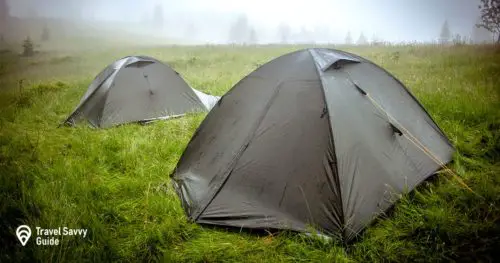If you’re a camping enthusiast, you won’t want the weather to keep you away from your next trip – which is why you need our guide to the best tents for rain.
There is a huge variety of tents out there that are ideal for bad weather. Whether you’re expecting the occasional rain shower or a downpour, you can find a tent that will keep you dry.
But how can you find the best one?
We really love the Coleman WeatherMaster 10-Person Tent – as the name suggests, it’s good for all kinds of weather. Keep reading to find out what’s so great about it.
We’d also suggest considering:
- MSR Hubba Hubba NX 2-Person Backpacking Tent – ideal for backpackers
- Coleman Octagon Tent – perfect if you’ve got a little more money to spend
Keep reading to find out more. We’ll be looking at:
- The best tents for rain compared
- What features to look for when you’re looking for a weatherproof tent
- 6 of our favorite tents for rain, including their specs, pros and cons
- Some of the most commonly asked questions about camping in the rain
- Which ones we love the best, and why
Let’s get going!
Table of Contents
- Best Tents for Rain Compared
- What to Look for in a Tent for Rain
- Top 6 Best Tents for Rain
- Coleman WeatherMaster 10-Person Tent – Best for Larger Groups
- Browning Big Horn – Most Versatile Layout
- NKT Super Arizona GT – Best for Extra Space
- MOON LENCE Instant Pop-Up Tent – Best for Quick Setup
- MSR Hubba Hubba NX 2-Person Backpacking Tent – Best for Backpackers
- Coleman Octagon Tent – Best on a Bigger Budget
- Frequently Asked Questions
- To Sum Up – Which Tent for Rain Should You Pick?
Best Tents for Rain Compared












What to Look for in a Tent for Rain
Let’s take a look at what you should be looking for in a tent that will withstand rainy weather.
Weatherproofing
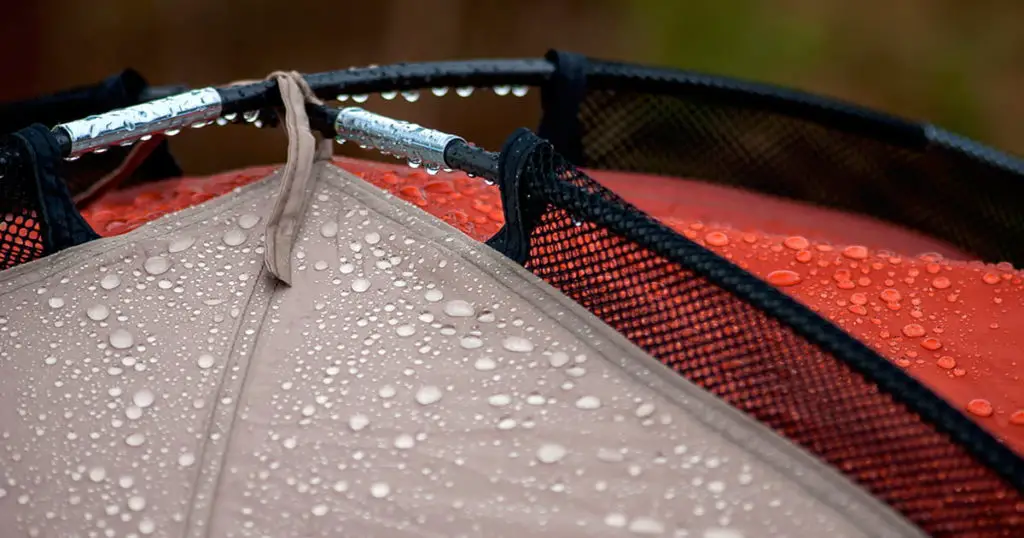
Obviously the first thing you’ll be looking at is weatherproofing. There are a few things you can look for if you’re trying to figure out whether a tent will be good for bad weather or not.
The first thing you can look at is hydrostatic head measurement. You may see a measurement in mm (millimetres). This measurement shows how much water can pool on top of your tent before it starts to seep through. If you want a waterproof tent, look for 2,000mm or more.
You might not see this measurement however, as not all manufacturers choose to use it. You can check for things like the materials used (more on that in a moment), as well as things like heat-sealed seams and covered zippers. These features can stop rain from coming in at the sides or through the entry ways.
Your tent should come with a rainfly. This is a cover, which protects the inner tent. Inner tents can be made from mesh, which is great for ventilation, but not so good for keeping the rain out. On warm evenings though, you can remove the rainfly and look out at the stars.
You may also have a tent footprint, which is a layer that goes on the ground to protect the bottom of your tent from moisture seeping through. Not all tents have a footprint included. You can buy one (like like this one or you can use a tarp like this one instead.
Materials
The materials used will give you a big clue as to how waterproof your tent will be. Rainproof tents will usually be made from one of the following:
- Polyester – this is a very popular material for tents. It’s usually coated in a solution like acrylic or polyurethane, which makes it more durable and water resistant.
- Poly Vinyl Chloride (PVC) – this is usually found in cheaper tents. It’s coated in the same way as polyester, but isn’t as durable or breathable, meaning it can cause condensation to start to build up. If you choose a PVC tent, make sure it has plenty of ventilation to compensate.
- Nylon – this is similar to polyester and PVC and is coated in the same way. The downside is that nylon is more likely to suffer from UV damage over time.
- Polycotton Canvas – this is a polyester/cotton mixture. It’s coated just like PVC, nylon, and polyester tents.
- Cotton – rarer to find, cotton tents can be waterproof, but you’ll have to weather them beforehand. This involves soaking them in water or leaving them in rain, which causes the fibres to swell. This prevents future leaks.
Tent poles create the structure of the tent (or the ‘frame’). They’re typically made from aluminum (cheaper but can break over time) or fiberglass (more expensive but more durable).
Seasons
Your tent will be described as having a ‘season’ which shows what kind of weather conditions it will be suited for. These are:
- 1 Season – these are very lightweight tents, ideal for festivals or weekend camping in warm conditions. They don’t tend to be very waterproof at all.
- 2 Seasons – these are not designed for heavy rain but can withstand the odd light shower.
- 3 Seasons – these are versatile tents, designed to cope with most weather situations. They are usually well ventilated, which is good for warm weather, but waterproof enough to deal with colder weather too.
- 4 and 5 Seasons – these are harder to find, and they’re either designed for very cold weather (4 seasons) or they’re specialist tents designed for expeditions (5-seasons).
If you’re not sure which you should pick, our 3-Season vs 4-Season Tent Comparison may help you to work out which one suits you best.
Size and Layout
Tents tend to fall under two broad categories: cabin tents and dome tents.
Cabin tents (like those in our guide to the best cabin tents) have straight walls, giving them an airy, spacious feel. They’re perfect for taller people (if you fall into that category, check out our guide to the best tall 4-person tents), or those that want to be able to walk around in their tent without having to duck.
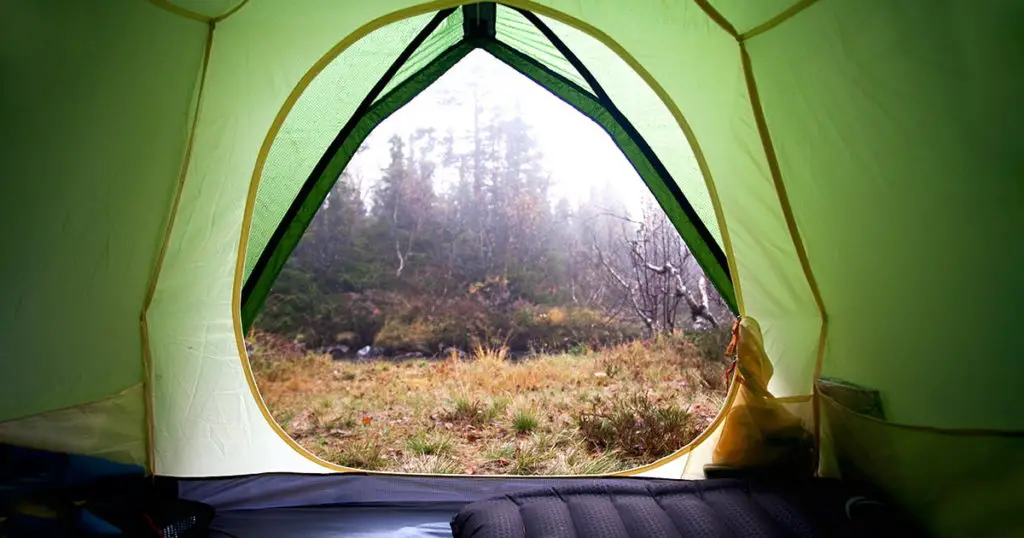
Dome tents (like those in our guide to the best dome tents) are, as the name suggests, dome-shaped. They have sloping walls, which means you may have to duck to get into them. They have the advantage of being better in windy weather, as they are closer to the ground and they have a smaller surface area for wind to push against.
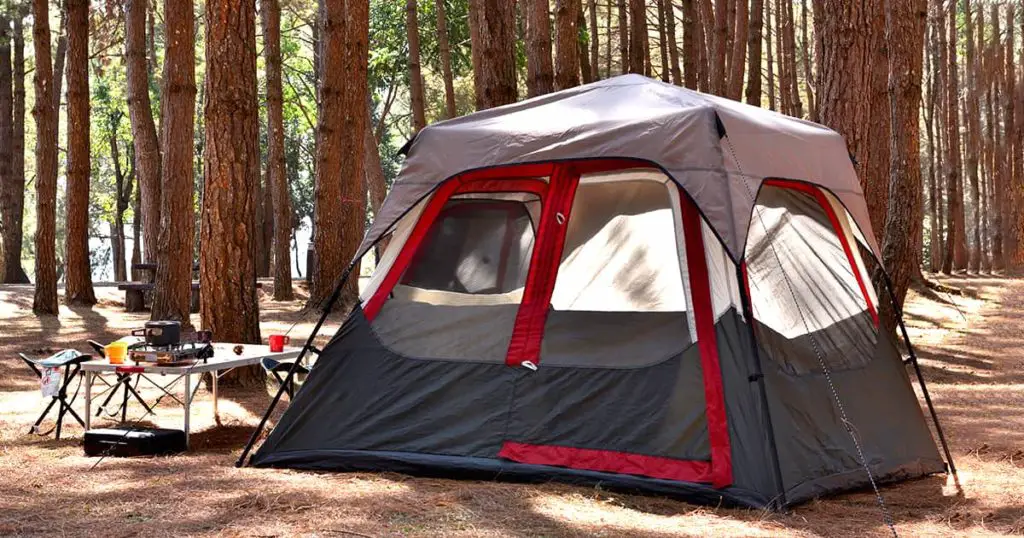
Tents have different layouts, so you should be able to find one that suits your needs. You can get multiple bedrooms (some tents have detachable inner walls, which makes them more flexible). You can get tents with enclosed porch areas to sit in, or vestibules for storing your gear. If you’re camping in rainy weather, you’re going to have waterproof gear like rain jackets to consider (for more info on those, check out our guide to the best travel jackets with hidden pockets for women or our guide to the best men’s travel jackets), in which case you could look for a tent with an overhead storage area.
Smaller pockets are useful too, especially for your smaller valuables.
It’s worth checking out the floor plan and size of your tent. Although tents can be advertised as for 5 people, for example, it might not be that roomy with 5 beds or sleeping pads inside.
Ease of Setup
Some tents (like instant camping tents) are so simple to set up – you literally shake them out of the bag and go. Others take a little more effort. It’s worth testing your tent before you leave for your first trip, to see what the process is like.
Look for tents with easy instructions, video guides, or color-coded poles if you’re a beginner.
Portability
If you’re backpacking, or you’re just tight on space, it’s a good idea to check out the size packed. This will show you how small your tent will be once it’s packed down into the bag it comes with.
It’s also worth checking the weight, again, especially if you’re backpacking and you’re trying to keep your carrying load down.
Top 6 Best Tents for Rain
Now let’s take a look at 6 of the best rain-proof tents in more detail.
Coleman WeatherMaster 10-Person Tent – Best for Larger Groups

Key Features
- Sleeps: 10
- Size:
17 x 9 x 6ft 8in (ft)
204 x 108 x 82 (in)
519 x 275 x 207 (cm) - Size packed:
30 x 10 x 10 (in)
76 x 25 x 25 (cm) - Weight: 31lbs / 14kgs
- Materials: PU-coated polyester
- Seasons: 3
The Coleman WeatherMaster 10-Person Tent has great weatherproofing credentials, as the name suggests. The coated polyester material is nicely waterproof, and it has fully taped seams, anti-wicking thread, and covered zippers, which will keep leaks at bay. The frame is nice and strong too, which is good for windy weather. It’s nice and durable, with users reporting that it lasts for a long time.
It’s great for larger groups. It sleeps 10, with two separate rooms. It has enough floor space for three queen-sized air beds. Perfect if you want a lot of room! It lacks overhead storage, which we feel is a bit of a shame, as it would have been handy to stash everyone’s gear out of the way. On the plus side, it has smaller storage pockets.
Despite its size, it’s straightforward to assemble. It has color-coded poles, which will help you to figure out what goes where. Plus, it has continuous pole sleeves, which will stop you from having to feed poles in and out of little gaps. The instructions are sewn into the carry case, so you won’t ever misplace them.
Pros
- Great waterproofing
- Holds up in windy weather
- Lots of floor space
- Easy and convenient to put together
Cons
- Lacks storage space
- Not easily portable
Browning Big Horn – Most Versatile Layout

Key Features
- Sleeps: 8
- Size:
10 x 15 x 7ft 2in (ft)
120 x 180 x 87 (in)
305 x 457 x 221 (cm) - Size packed:
12 x 30 (in)
30.5 x 76 (cm) - Weight: 35lbs / 16kgs
- Materials: Polyester
- Seasons: 3
The Browning Big Horn is pretty good for keeping the rain out, thanks to the 2,000mm-coated polyester. The flooring is durable, which will prevent dampness from setting in. It has sealed seams, to stop leaks during very heavy downpours. The fiberglass frame holds up well in windy weather. Plus, there’s a mesh roof – perfect for those moments where the sun comes out.
It’s a nice versatile choice, as it has a detachable room divider. You can change it up for each trip, depending on what you need. It has floor space for two queen-sized beds with a bit of room leftover. It has small storage pockets, but doesn’t have overhead storage, which is a bit inconvenient.
It’s fairly simple to put together – it takes around 15 minutes for two people, which isn’t too bad considering it’s quite a large tent.
Pros
- Great waterproofing
- Strong frame
- Versatile layout
- Easy setup
- Easily portable
Cons
- Lacks overhead storage space
NKT Super Arizona GT – Best for Extra Space

Key Features
- Sleeps: 11-12
- Size:
6ft 9in x 10ft 2in x 20ft 6in (ft)
83 x 122 x 247 (in)
210 x 311 x 627 (cm) - Size packed:
24 x 18 (in)
61 x 46 (cm) - Weight: 6.5kg /18.74lb
- Materials: Anti-fungal polyethylene
- Seasons: 3
The NKT Super Arizona GT is a heavy-duty tent. The outer tent has a hydrostatic head measurement of 2,500mm, which is pretty good in terms of keeping rain out. It has heat-welded seams to prevent leaks, too. Plus, it has UV protection and super-strong fiberglass poles, which is great for windy weather. The flooring has an anti-fungal coating, which again, makes it ideal for damper weather as you won’t have to worry about mold.
It’s also huge! It has a detachable room divider, which is useful, but it also has a gear loft, large pockets for all your essentials, and extra poles so you can use an extended canopy. Perfect if you want to sit outside and enjoy the view.
It’s not difficult or confusing to put together, but due to the size, it can be time-consuming. It also requires at least 2 people to put together. It’s on the heavier side, too, thanks to the size.
Pros
- Great waterproofing
- Strong, windproof frame
- Detachable inner wall
- Lots of storage space
- Detachable inner wall
Cons
- Time consuming to set up
- Heavy to carry
- Not easily portable
MOON LENCE Instant Pop-Up Tent – Best for Quick Setup

Key Features
- Sleeps: 5
- Size:
9 x 10 x 4ft 3in (ft)
114 x 122 x 52 (in)
290 x 308 x 133 (cm) - Size Packed:
33 x 7 x 7 (in)
83 x 18 x 18 (cm) - Weight: 10.25lb / 4.65kg
- Materials: Polyester-coated cloth
- Seasons: 3
The MOON LENCE Instant Pop-Up Tent offers pretty good waterproofing for an instant tent. It has a hydrostatic head measurement of 2,000mm, which is pretty decent, and it has covered zippers to prevent leaks. It has small mesh windows for ventilation on warmer days. Because it’s an instant tent, the frame may not be as durable as it would be on a tent using regular poles, as the frame is thinner and less robust. You may think this is a small price to pay for the speed of setup, but more on that in a moment.
It’s a tight squeeze for 5 people. It would be better suited for 4 (or for a family with smaller children). The tent has small pockets, but no overhead storage, so you’ll have to factor in where you’ll keep your gear. It does have a hook for a lantern on the ceiling, which is a nice touch.
Obviously, the setup is very simple. Just pull up the middle, straighten out the poles, and it all clicks into place. It takes just moments to do, and it folds up into a small, lightweight bag. Ideal for backpackers.
Pros
- Good waterproofing
- Decent ventilation
- Really easy setup
- Easily portable
Cons
- Not much storage space for gear
- Frame not as durable as others on this list
MSR Hubba Hubba NX 2-Person Backpacking Tent – Best for Backpackers

Key Features
- Sleeps: 2
- Size:
6ft 9in x 4ft 1in x 3ft 2in (ft)
84 x 50 x 39 (in)
213 x 127 x 100 (cm) - Size Packed:
18 x 6 (in)
46 x 15 (cm) - Weight: 3.79lb / 1.72kg
- Materials: Polyurethane and silicone-coated nylon
- Seasons: 3
The MSR Hubba Hubba NX 2-Person Backpacking Tent has great rainproofing credentials. Although the 1,500mm hydrostatic head measurement on the rainfly is a little less than we’d like, it’s still fairly waterproof for such a lightweight tent. It has a rainfly which you will need to buy separately, but it’s well worth the purchase – it has a hydrostatic head measurement of 3,000mm. So, if you do find yourself camping on a deep puddle, you should still stay pretty dry underfoot. It has good ventilation, and users describe it as being durable.
It’s a tiny tent. Even for 2 people, it’s going to be a squeeze, and there’s definitely not much space for lounging around in. If you’re backpacking and you just need a place to crash at night, it’s ideal. It has a rollup vestibule, which can be used for storage, and you can roll it all the way up to look out at night. It also has storage pockets.
It’s really simple to put together, with color-coded poles. It’s super lightweight and folds down very small, so if you’ve only got a tiny bit of space, it works well.
Pros
- Decent rainproofing
- Durable
- Good storage
- Lightweight and packs down small
Cons
- Footprint has to be bought separately
- Tight squeeze for 2 people
Coleman Octagon Tent – Best on a Bigger Budget

Key Features
- Sleeps: 6
- Size:
12ft 9 in x 12ft 9in x 7 (ft)
155 x 155 x 84 (in)
393 x 393 x 213 (cm) - Size Packed:
33 x 12 x 12 (in)
85 x 30 x 30 (cm) - Weight: 48.85lbs / 22.15kg
- Materials: Polyester
- Seasons: 3
The Coleman Octagon Tent is great for keeping the rain out. It is coated with Coleman’s Weather Tec system, a special coating which is designed to be rain resistant. The hydrostatic head measurement is 2,000mm, and it has fully taped seams to keep leaks at bay. The groundsheet (or footprint) is sewn in, meaning you’ll be protected from moisture seeping in from the ground. It has a strong, durable frame. It’s also ideal for warmer weather. There are six large windows which can be fully unrolled, revealing the mesh underneath. This means you can see out clearly on the off chance you do have some sunny days on your trip.
As you may be able to tell from the measurements, it’s a large tent. It has tons of head room, which is good for taller campers, and it’s perfect if you’re travelling in a larger group. The tent has a removable partition curtain for privacy. It has small storage pockets, but no overhead storage. This may not be too much of a problem though given how much floor space there is.
In terms of setup, it’s actually pretty simple given the size. The instructions are clear, and most people found it to be straightforward. Because it’s so large, it’s recommended that 2 people put it together. It’s a heavy tent, so that’s something to bear in mind – it’s not designed to be carried for long periods of time!
Pros
- Good rainproofing
- Great ventilation
- Ideal for stargazing
- Tons of space
Cons
- No overhead storage
- Heavy to carry
- Not easily portable
Frequently Asked Questions
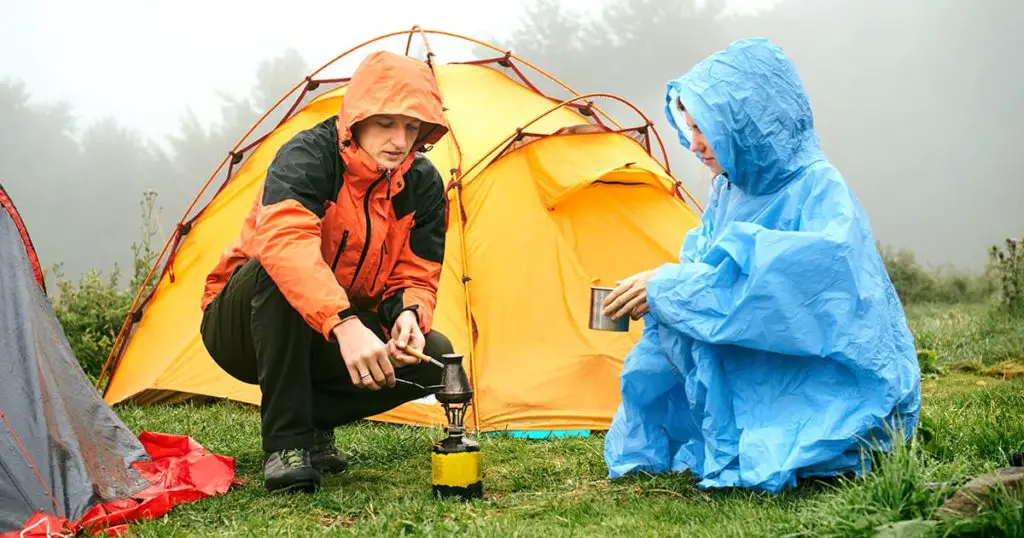
Here are a few of the most frequently asked questions about tents for rain:
Can I make my tent more waterproof?
Although the tents on this list are designed to be waterproof already, you can make tents more waterproof by using a spray (like the . Always check the instructions to make sure your tent has suitable fabric to be treated.
How do I fix leaky seams on my tent?
Leaky seams are really common, especially in older tents or tents with poorer quality stitching. You can fix leaks in your tent seams by using a seam sealer like this one by Gear Aid.
How long do tents stay waterproof?
We can’t put a firm number on this because there are a variety of factors involved, but tents can stay waterproof for a good few years, especially if you re-treat them occasionally using water repellent spray.
What gear do I need to consider bringing when camping in the rain?
Obviously you’ll want a decent travel coat or poncho for hiking to keep you dry. A heavy-duty backpack that won’t let in leaks is ideal (like the Teton Sports Scout 3400 – something that will be robust, especially if you want to go hiking or walking). Other than that, you’ll want to bring the usual gear that you would want to bring camping – bedding, torches, etc.
To Sum Up – Which Tent for Rain Should You Pick?
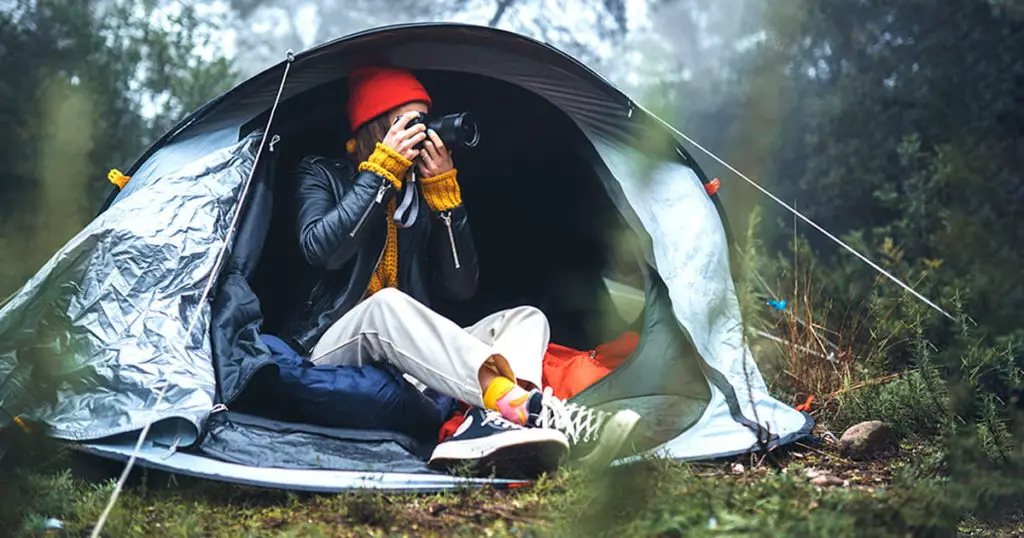
As we mentioned way back in the intro, we do really like the Coleman WeatherMaster 10-Person Tent. The weatherproofing is great, so it should keep you dry. It’s easy to set up, and it has plenty of space. The only thing we’d change is the lack of overhead storage.
We also like the MSR Hubba Hubba NX 2-Person Backpacking Tent, which is decently waterproof if you buy the footprint too. It’s lightweight and easy to set up, which is great.
If you’ve got room in your budget, it’s definitely worth looking at the Coleman Octagon Tent. It’s very spacious, and the large mesh windows are excellent for stargazing.
We hope this has helped you to find the best tent for rain!
